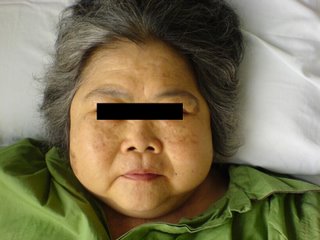Spot diagnosis: Cushing's syndrome


Cushing's syndrome is another popular spot diagnoses in PACES. The candidate is usually asked to "Look at the patient's face".
There are 3 main steps in dealing with this case:
First, be able to recognise all the striking features of Cushing's syndrome.
** Typical moon-face with plethora, hirsutism and acne.
** Truncal obesity with interscapular and supraclavicular fad pads.
** Purple striae over the abdomen, around the shoulders and breasts and thighs.
** Thin skin and easy brusing commonly found over limbs
** Proximal myopathy (shoulders & hips) and spinal tenderness (osteoporosis)
Then, you must always look out for the possible underlying diagnosis as it is not enough for a PACES candidate to get the diagnosis of Cushing’s syndrome only in MRCP.
Lastly, please complete your examination by mentioning that you would like to measure the BP and test the urine for sugar.
Points to remember: The commonest cause is still iatrogenic i.e. secondary to steroid. So, please look for RA hands, gouty arthritis, nephrotic syndrome and etc. 
What is the other cause for Cushing's syndrome?








0 Comments:
Post a Comment
<< Home